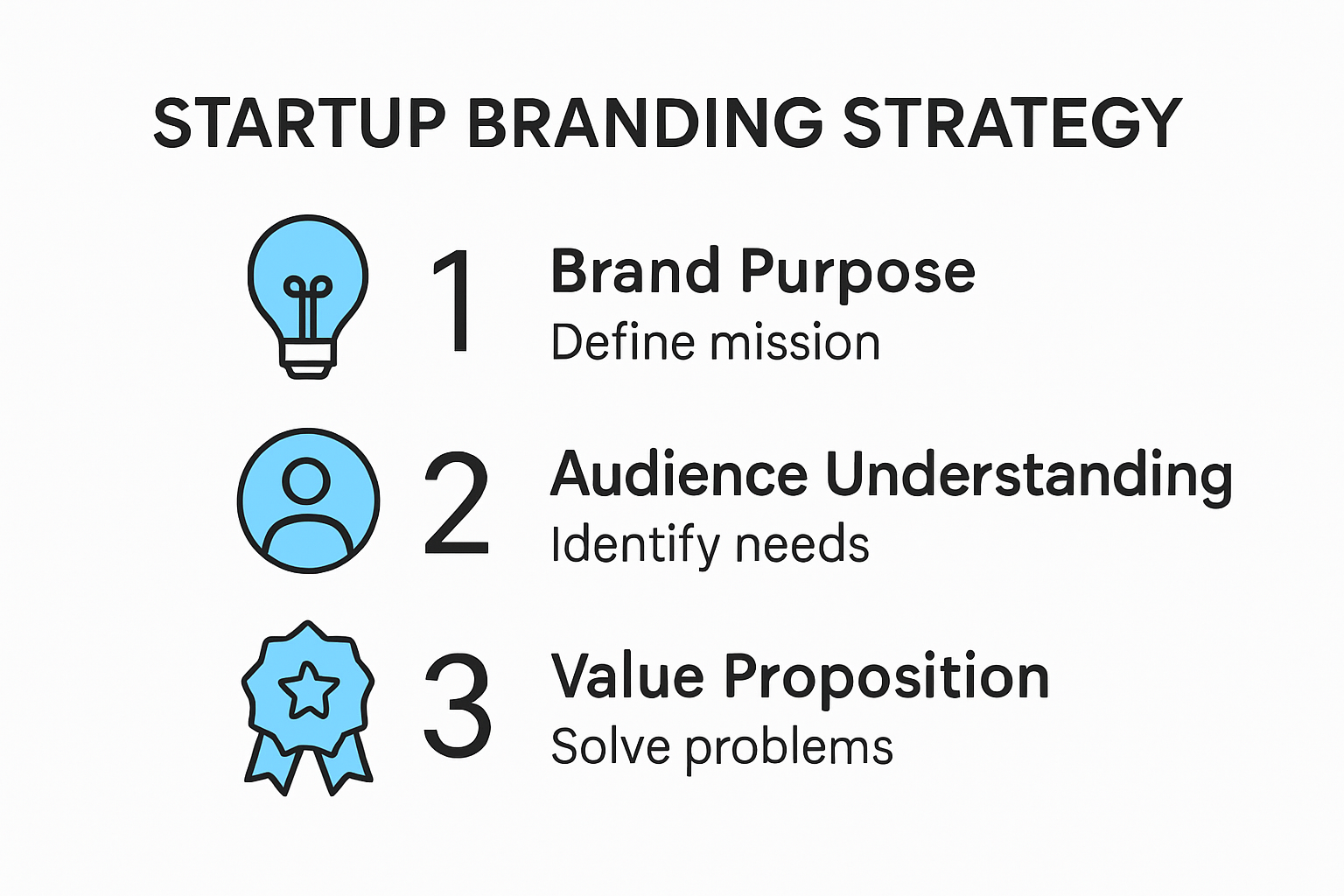Branding strategy shapes how startups make their mark and stand out from the crowd. Most people think it is just about picking colours or designing a cool logo and moving on. But one powerful fact stands out. Startups with a strong branding strategy can command premium pricing and attract more loyal customers than those without a plan. The real magic lies in how branding strategy builds trust and makes people choose your business over everyone else.
Table of Contents
- What Is Branding Strategy And Why Is It Important?
- The Core Elements Of A Successful Branding Strategy
- How Branding Strategy Influences Customer Perception
- Real-World Examples Of Effective Branding Strategies
- Measuring The Impact Of Your Branding Strategy
Quick Summary
| Takeaway | Explanation |
|---|---|
| A branding strategy defines identity. | It outlines how a startup communicates its unique values and identity to its target audience effectively. |
| Understand your target audience deeply. | Comprehending customer needs and pain points is crucial for effective branding and market presence. |
| Differentiation enhances customer trust. | A strong branding strategy builds trust and creates memorable experiences that set your startup apart. |
| Consistency is key to brand perception. | Delivering a consistent brand message across all platforms fosters credibility and customer engagement. |
| Measure both quantitative and qualitative impacts. | Use metrics and feedback to evaluate the effectiveness of your branding strategy comprehensively. |
What is Branding Strategy and Why is it Important?
A branding strategy represents a comprehensive plan that defines how a startup communicates its unique identity, values, and promise to its target audience. It goes beyond merely designing a logo or selecting corporate colours - it is a strategic framework that shapes how customers perceive and interact with your business.
The Core Components of Branding Strategy
Successful branding strategy incorporates several critical elements that work together to create a cohesive and compelling business narrative:
- Brand Purpose: Clearly articulating why your startup exists beyond making profit
- Target Audience Understanding: Deeply comprehending your ideal customer’s needs, preferences, and pain points
- Unique Value Proposition: Defining what makes your startup distinctly different from competitors
According to OpenStax’s Entrepreneurial Branding research, a brand should have a clear purpose derived from the company’s mission, effectively communicating its unique selling proposition throughout all marketing efforts.
Why Branding Strategy Matters for Startups
For emerging businesses, a robust branding strategy serves multiple critical functions. It helps establish credibility, build emotional connections with customers, and create a memorable market presence. Without a strategic approach, startups risk becoming indistinguishable in crowded market segments.
Startups that invest time in developing a comprehensive branding strategy gain significant advantages: they can command premium pricing, attract loyal customers, and create a strong foundation for long-term growth. Learn more about crafting a powerful brand statement to understand how to articulate your startup’s unique narrative effectively.
Key benefits include:
- Differentiation in competitive markets
- Enhanced customer recognition and recall
- Increased trust and perceived value
Ultimately, a well-executed branding strategy transforms a startup from a generic business entity into a distinctive, memorable brand that resonates with its target audience.
To better understand the foundational elements that shape an effective branding strategy for startups, the following table summarises the core components, their descriptions, and their significance as outlined in the article.
| Core Component | Description | Significance |
|---|---|---|
| Brand Purpose | Why your startup exists beyond making profit | Drives mission and sets brand direction |
| Target Audience Understanding | Comprehension of ideal customers’ needs, preferences, and pain points | Enables tailored messaging and engagement |
| Unique Value Proposition | Defining what makes your startup different from competitors | Facilitates differentiation and relevance |
| Brand Identity | How you want your startup to be seen (mission, visual, voice) | Shapes consistent perception and recall |
| Brand Positioning | How your startup is presented and differentiated in the market | Enhances visibility and competitive edge |
The Core Elements of a Successful Branding Strategy
A successful branding strategy is not a single action but a holistic approach that integrates multiple strategic components to create a compelling and consistent brand narrative. For startups, understanding these core elements becomes crucial in establishing a distinctive market presence.
Defining Your Brand Identity
Brand identity represents the foundational blueprint of how your startup wants to be perceived. According to Rhode Island Small Business Development Center, being purpose-driven and unique are critical first steps in developing a robust brand strategy.
Key aspects of brand identity include:
- Mission and Values: Articulating the deeper purpose behind your startup
- Visual Language: Consistent design elements that communicate your brand’s personality
- Voice and Tone: A distinctive communication style that resonates with your target audience
Strategic Brand Positioning
Brand positioning determines how your startup differentiates itself in a competitive marketplace. This involves identifying your unique value proposition and understanding precisely who your ideal customers are. Learn more about building brand credibility to understand how strategic positioning impacts customer perception.
Effective positioning requires:
- Comprehensive market research
- Clear understanding of customer pain points
- Authentic communication of your startup’s distinctive capabilities
A well-crafted brand positioning strategy transforms your startup from just another business into a memorable, compelling brand that customers actively seek out and recommend.
Ultimately, the most successful branding strategies are those that remain genuine, adaptable, and consistently aligned with the startup’s core mission and values.

How Branding Strategy Influences Customer Perception
Customer perception represents the complex psychological process through which individuals interpret, understand, and form opinions about a startup’s brand.
A strategic branding approach directly shapes these perceptions by carefully managing every interaction and communication touchpoint.
The Psychological Foundations of Brand Perception
Customers do not merely see a brand as a product or service, but as a multifaceted entity with emotional and rational dimensions. According to research in the International Journal of Environmental Research and Public Health, a strong and consistent branding strategy significantly influences consumer trust and engagement.
Key psychological factors that impact brand perception include:
- Emotional Resonance: How well the brand connects with customer feelings and values
- Consistency: The predictability and reliability of brand messaging
- Authenticity: The genuine representation of the startup’s core mission
Building Trust Through Strategic Branding
Trust emerges as a critical outcome of strategic branding. When startups communicate transparently and align their visual, verbal, and experiential elements, they create a cohesive narrative that customers find credible and compelling. Explore strategies for enhancing brand credibility to understand how perception drives customer decisions.
Perception-building strategies involve:
- Delivering consistent brand experiences across all platforms
- Demonstrating genuine understanding of customer needs
- Communicating brand values through meaningful storytelling
Ultimately, successful branding transforms customer perception from passive observation to active engagement, turning potential customers into brand advocates who not only purchase but also recommend and defend the startup’s offerings.
Real-World Examples of Effective Branding Strategies
Successful branding strategies transcend theoretical concepts by demonstrating practical application across diverse industries. Startups can learn valuable lessons by examining how innovative companies transform their brand narratives into compelling market propositions.
Disruptive Market Positioning
Companies like Beyond Meat exemplify how strategic branding can redefine entire market segments. According to research on innovative business strategies, Beyond Meat successfully positioned itself by targeting a broad audience beyond traditional vegetarian markets, leveraging sustainability messaging and strategic partnerships.
Key elements of disruptive branding include:
- Purpose-Driven Narrative: Communicating a mission larger than product sales
- Strategic Targeting: Expanding market reach beyond traditional boundaries
- Innovative Messaging: Challenging existing industry perceptions
Personalisation and Customer Connection
Effective branding strategies recognise the power of personalised experiences. Explore advanced personalisation techniques to understand how tailored interactions transform customer relationships.
Successful personalisation strategies typically involve:
- Creating segmented customer experiences
- Leveraging data-driven insights
- Developing adaptive communication approaches
Startups that master the art of personalised branding can create deeper emotional connections, transforming transactional relationships into lasting brand loyalty. The most impactful branding strategies are those that make customers feel uniquely understood and valued.
Measuring the Impact of Your Branding Strategy
Measuring a branding strategy’s effectiveness requires a multifaceted approach that goes beyond traditional marketing metrics. Startups must develop a comprehensive framework to understand how their brand narrative translates into tangible business outcomes.
Quantitative Performance Indicators
According to research in Management Science, startups can measure strategic differentiation through sophisticated analytical techniques that assess their unique value proposition. This approach helps evaluate how effectively a brand distinguishes itself in the marketplace.
Key quantitative metrics include:
- Brand Recognition: Tracking mentions, social media engagement, and awareness levels
- Customer Acquisition Cost: Measuring marketing spend relative to new customer conversion
- Customer Lifetime Value: Assessing long-term revenue potential from brand loyalty
Qualitative Brand Impact Assessment
Beyond numerical metrics, startups must understand the emotional and perceptual dimensions of their brand. Explore strategies for enhancing brand credibility to gain deeper insights into brand perception.
Qualitative evaluation methods involve:
- Conducting customer feedback surveys
- Analyzing sentiment across digital platforms
- Monitoring brand narrative consistency
The most successful startups recognise that brand impact is not just about immediate financial returns, but about building a sustainable narrative that resonates with their target audience and creates lasting market differentiation.
The following table outlines the key quantitative and qualitative ways to measure the impact of your branding strategy, helping startups track both tangible results and deeper emotional outcomes.
| Measurement Approach | Key Metrics or Methods | Purpose/Outcome |
|---|---|---|
| Quantitative | Brand Recognition, Customer Acquisition Cost, | Tracks awareness, efficiency, and growth |
| Customer Lifetime Value | ||
| Qualitative | Customer Feedback Surveys, Sentiment Analysis, | Assesses emotional resonance and consistency |
| Brand Narrative Consistency Monitoring | ||
| Research/Analytics | Market differentiation analysis via advanced techniques | Evaluates impact of unique value proposition |

Bring Your Startup Brand to Life with Tailored Digital Solutions
You have read how a thoughtful branding strategy can be the difference between blending in and carving out a unique space in the market. If you are struggling to turn your brand identity or positioning into an engaging digital experience, you are not alone. Many startups find it difficult to move from brand concepts like mission, values, or recognisable visual language into compelling, conversion-focused online platforms. This gap can hurt customer trust and make it harder to become memorable and credible in a crowded space.
Whether you want to showcase your brand’s story, build credibility, or connect emotionally through your website, Cloudfusion’s web design and development team can help bridge that divide. Our full-service digital solutions optimise brand purpose, integrate personalisation, and support measurable growth for startups that want more than just a website. Ready to transform your brand strategy into a world-class digital experience today? Request your custom web design and development quotation and let us help your startup stand out. Discover the advantages of expert branding insight and technology combined at Cloudfusion.
Frequently Asked Questions
What is a branding strategy?
A branding strategy is a comprehensive plan that defines how a startup communicates its unique identity, values, and promise to its target audience. It shapes perceptions and interactions between customers and the business.
Why is a branding strategy important for startups?
A branding strategy is crucial for startups as it helps establish credibility, build emotional connections with customers, and create a memorable market presence, enabling differentiation and long-term growth in competitive markets.
What are the core components of a successful branding strategy?
The core components include brand purpose, understanding the target audience, and defining a unique value proposition. Additionally, establishing a clear brand identity and strategic positioning is vital for success.
How does branding strategy influence customer perception?
Branding strategy influences customer perception by carefully managing interactions and communications, creating emotional resonance, consistency, and authenticity which fosters trust and engagement with the brand.








